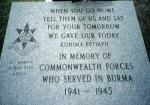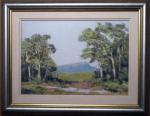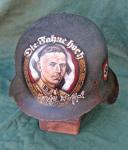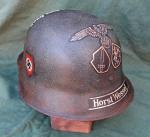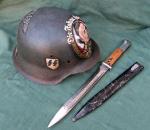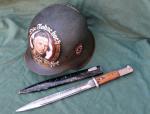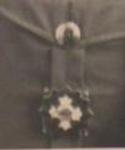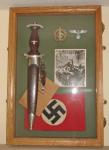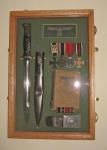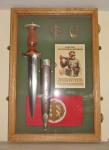-
Posts
1,869 -
Joined
-
Last visited
-
Days Won
7
Content Type
Profiles
Forums
Blogs
Gallery
Events
Store
Everything posted by Spasm
-
Gents Here's the link to the Imperial War Museum's WW1 Centenary Events Calendar http://www.1914.org/events-calendar/ Events organised all over. I spotted one in India. Have a browse through, looks like some are going to be well worth visiting. Maybe even take a camera and share with all.
-
Great photos and a great place to visit Harry. The British and Indian 2nd Division under Maj Gen John Grover was to fight its most famous battle at Kohima. In 1944, during the Burma Campaign, the Division relieved the embattled garrison at Kohima in the Naga Hills. Despite being hampered by the monsoon rains and treacherous terrain, Allied soldiers succeeded in taking Kohima in hand-to-hand fighting, most famously on the Deputy Commissioner's tennis court. This battle was ultimately to prove the turning point of the war against the Japanese in Burma. The Kohima fighting resulted in the loss of around 4,000 dead, wounded and missing Indian and British soldiers, the Japanese lost more than 7,000. A memorial at the battleground is inscribed with the Kohima Epitaph
-
Colin Yes, good site. They seem a lot more critical but then they all do this sort of stuff as well. I think you are probably your loudest critic, I am certainly more critical about my own work than anyone else (other than the admin staff obviously) - quite a lot still goes under the sander or in the bin. I'll keep going to have a look on there to see the WIP pictures. Crack on Steve
-
Cor, another nice one coming along Colin. I love these. Just great. Be nice to see more pictures of the work in progress. Stuff and tools in use as the figure progresses.
-
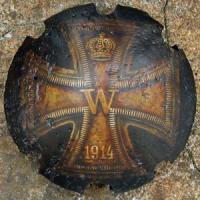
Getting the Wrinkels Out
Spasm replied to Brian Wolfe's topic in Preservation & Restoration of Military Artifacts
Brian Good stuff. I was wondering how to straighten out a piece of aluminium from an Me109 to allow me to paint it. Now I know - once I figure how to get the folds out without snapping it. -
He has no feedbacks but already has 2 followers.
-
Very nice work. Well done, I know how hard medals are to paint. Bronze and gold are fairly easy, the silver ones are really hard to get right and take an age to do. And I like the way you've extended the ribbon to show both sides of the medal. Nice one.
-
- 4 replies
-
- TINNIE
- IDENTIFICATION
-
(and 1 more)
Tagged with:
-
That's very nice indeed, love it
-
Maximised damage available to anyone who wants to buy them advertised by someone who purposely sounds like Clint Eastwood. Don't ammunition manufacturers and suppliers need some form of licence. Why would anyone want these things? To shoot at targets, pieces of jelly, watermelons and Sainsbury's chickens I suppose. I have absolutely no idea why these would even be considered by any combat or security type professionals.
-

World War 1 - The Great War - BBC Documentary - Episode 1
Spasm replied to IrishGunner's topic in The Great War 1914 to 1918
All watched, well worth it. The very last bonus episode is a Film of WW1 US troops training in grenade throwing, bayonet fighting and running around stabbing things. -
Can't help you with the first two, but the third one looks to me like a school badge given to the rugby 1stXV or cricket 1stXI vice captain. I only ever made 4th squad as I hated both and played on the fields full of devil thorns. Happy days. Yeah right. Could be the vice captain of the school as well I suppose.
-
Here's some display cases that I have. Bought in the UK but am now unable to find the supplier here, I expect they are around somewhere. They are available in the US from www.shadowboxonline.com I haven't had any from this site so no experience of them but the display boxes are pretty good. They come in various sizes to suit, oak, walnut or cedar with a foam insert and a felt backing in a choice of colours. I remove the foamy stuff and use mounting board as a backing. Mounting board is stuff friendly and comes in any colour you want from your local arty shop. The back is hardboard so easily drilled to take dowels, mounting etc for your big boys toys. Good thing is that they are hinged and have a lock clip that has a key (keeps those little prying fingers away).
-
Just found this. A comment on the BBC's WW1 website: (not mine I hasten to add) Quote "Thanks Dan Snow. Now we know that it wasn't the bloodiest war, only 12% died, only a mere 30% of time was spent in the trenches so that's not too bad, the generals did a grand job and reacted swiftly to change their tactics in the face of failure, the ANZACS suffered significantly less then Brits at Gallipoli, lots of people loved the war, etc. Thanks Michael Portillo. The war didn't change much itself, but just delayed the changes which were already happening. Thanks Ian McMillan. Now we know the war poets lied or exaggerated and the millions of deaths and maimings were not so terrible after all. Makes you wonder what all the fuss is about then. Makes you wonder why every village has a memorial. Makes you wonder why so many who took part would never talk about it. Sorry we were all so gullible as to fall for the leftie nonsense spouted about it in the 1960s. Obviously it wasn't as significant as episode as we all thought."
-
Brian Nothing against the Snow family. In fact I like all of their programmes as they are very easy to watch, have good content and well presented. Dan is pushing his beliefs because he is becoming one of those 'celebrities' that all have an opinion and think that everyone has the right to hear them rather than remaining as a very good and knowledgeable presenter. Ok, that's his choice as a TV star and I can choose to watch him or not. The thing that is getting me is that both him and the BBC (who have produced some really great WW1 documentaries, one a 29 part series, with another starting this week presented by Jeremy Paxman) have decided to make a big thing about these so called myths on the back of some political row over teachers. Look a bit more at the BBC's link http://www.bbc.co.uk/ww1 Right, back to the trench
-
David The second one is a modern reproduction of the Fairburn Sykes commando fighting knife. A lovely knife to hold. The scabbard tabs and elastic look too new to be anything else. Here's a good site that has photos of most of the FS style knives available. There are some wide bladed ones shown. http://www.gotavapen.se/gota/artiklar/fs/new/fs_new.htm
-
The Nations involved in WW1 called their men to arms. The men answered that call. Probably as they would today. Conscription started in Britain in 1916 well after the trenches had been dug. I agree with Irish, the word "myth" grew from the political row between Grove and Baldrick. And I think the BBC have sort of jumped on the bandwagon by allowing their websites and programmes to be headed by a bag of other "myths". Dan Snow historian and coming out atheist that attended the Royal wedding (dad John swingameter expert, cousin Jon newsreader and wife daughter of Duke of Westminster with seven billions of pounds) is heading these "myths" for them. He says wars have been recounted by artists/poets/writers/film makers rather than historians. These are said to be more easily and better remembered by the public. He says he has no problem with the Enigma being shown captured by Americans or that the painting of Hannibal over the mountains is incorrect. So why do this on the 100 year anniversary of WW1, and with backing from the BBC? I disagree with many of the points he raises. Saying that many enjoyed it and that 9 out of 10 came home is just (quoting Eric) pc bs. We can all go away and read some books and make up our own minds. I wasn't there, but nor was he.
-
Yes, the article's points are cleanly given and can raise some interesting discussions. 1. The Taiping Rebellion was a civil war, still a war but not a war between countries. Civil Wars were seemingly endless in the 19th C, the Sudan Mahdist that killed over 5M or the Congo's 4M or the Panthay Rebellion with another 1M or Venezuela with another 1M, Mfecane another 1.5M. 2. During the Crimean war the soldiers had a much larger chance of dying from disease. Of the 90,000 French dead, 60,000 died of disease, Britain's 21,000 dead was 16,000 from disease. A far larger % dead amongst the mobilised army but two thirds from disease. 3. Of course men were in the trenches for years. Front and rear trenches were under fire for long periods of time, rest periods were spent drilling, marching, training and still out in the elements lodging in broken shells of houses or canvas. So, a fighting regiment soldier who lasted the whole war was, given the article's figures, 10 days a month in the trenches. Over a 50 month war that's 500 days, sounds pretty bad to me. 4. This may have ben true in 1914, but the expansion of the peacetime army meant that most of the "junior" officers came from middle class or working class backgrounds. ANZACs were less class-ridden throughout, as were the Americans, later on. Just counting the officer deaths has no meaning. 5. Again as the article says the Canadian General worked with his men and fought in a different manner. The major French led offences in early 1918 were nothing more than they were in 1914 - throwing massed armies onto the guns. 6. Galipolli was a disaster for the ANZACs and also the allied armies. The whole enterprise was a disaster that the Kiwis and Aussies chose to quite rightly commemorate. 7. Tactics didn't change. How could they? Millions of men dug in facing each other. All the great war inventions, gas, flamethrowers, mines, tanks, bombers, stormtroopers all had limited success but were ultimately held by the opposing army until one of those armies bled to death. The Russians turned their backs, the Turks and Austrians were bled to death, the French very nearly turned away, the Allies were bleeding due to the extra German divisions released from Russia until the Americans came over and ultimately the Germans were bled to death and had to give way. 8. Devastation was inflicted onto everyone. But the invaders were eventually thrown out on their arse. 9. The treaty was extremely harsh and untenable. It is generally seen as paving the way to WW2. Keynes lays out some of the economic reasons. How could Germany survive under those conditions - Keynes says that the treaty condemned millions to starvation. 10. What! Of course everyone hated it. The women wanted their dads, husbands, brothers, sons home and safe. The men dreamed of going home, and they didn't get meat every day. Jeez. Maybe the people who made a great deal of money didn't hate it so much. I'll go hide in my trench.
-

Unidentified 8th London - Post Office Rifles
Spasm replied to Spasm's topic in The Great War 1914 to 1918
Paul thanks Yes, I already have that. It is a good small potted history of the Battalion written in Feb 1919 by their CO Lieutenant-Colonel A.D. Derviche-Jones DSO MC. But, alas, the list of honours is exactly that, a list of names below the awards, no dates or places. 2nd Lt. J.M. Barratt is amongst the 36 MC awardees listed. Perhaps I'll order the Battalion's War Diaries from the National Archives but I'm not sure if that will even have the details I'm looking for.



